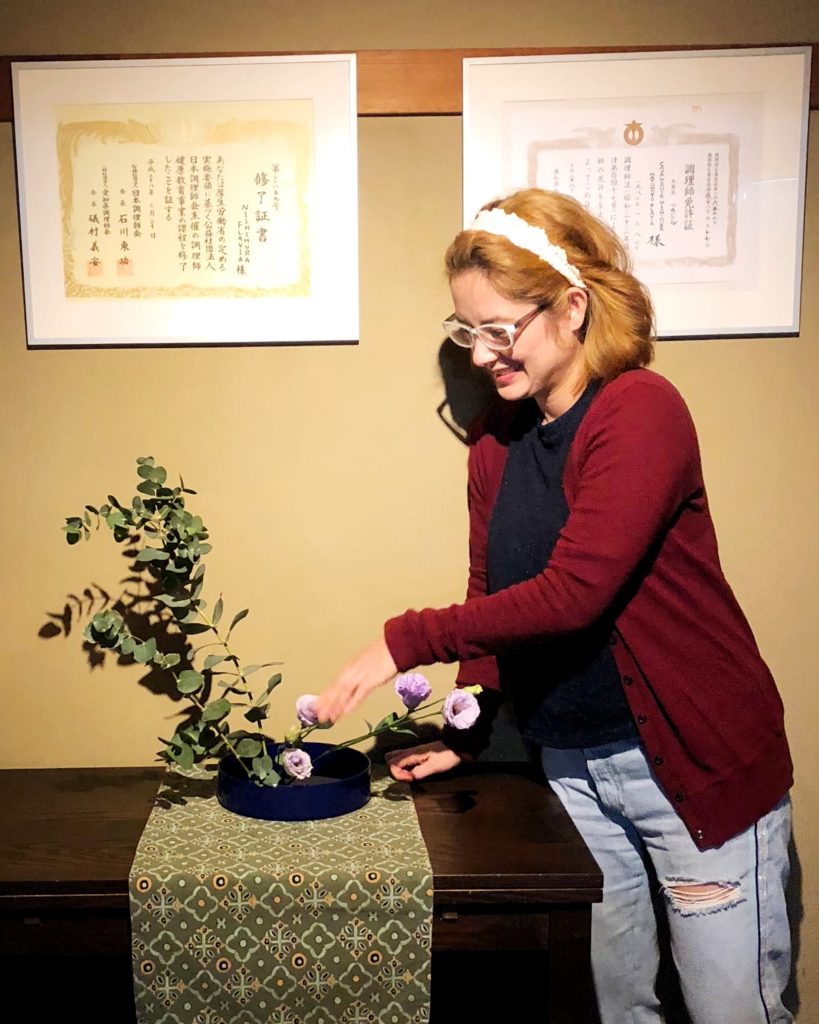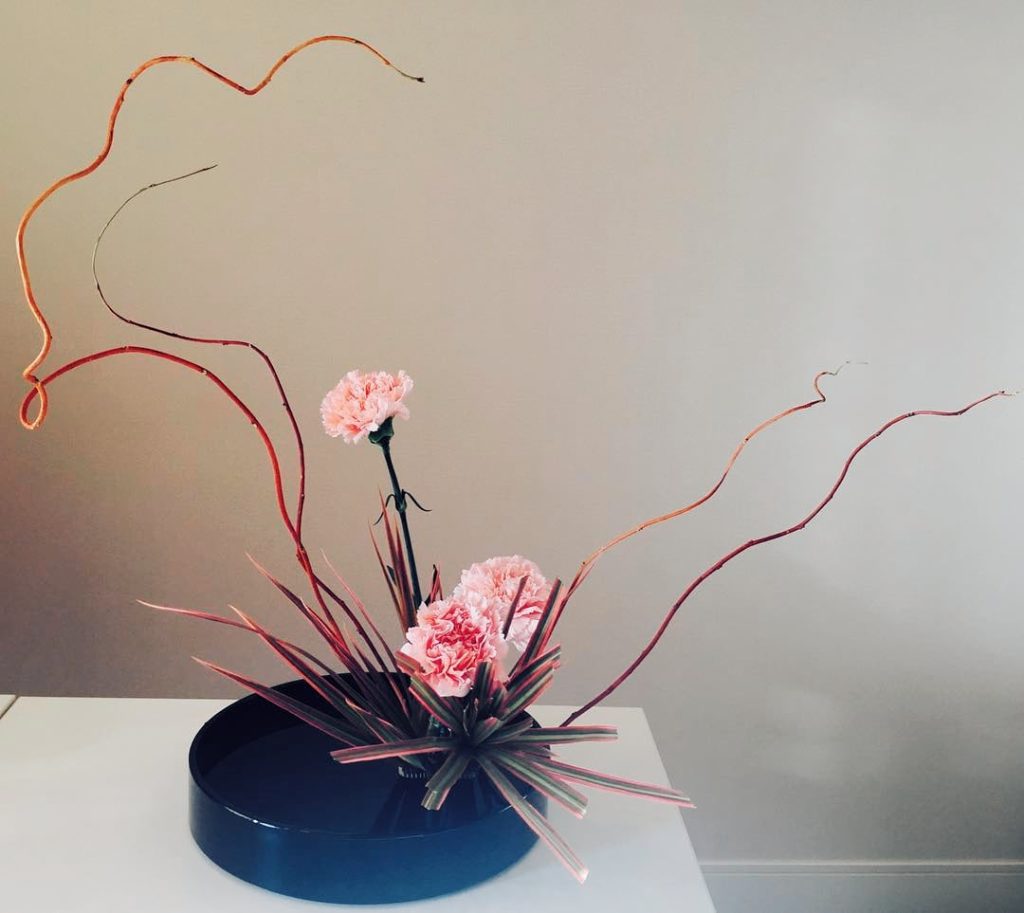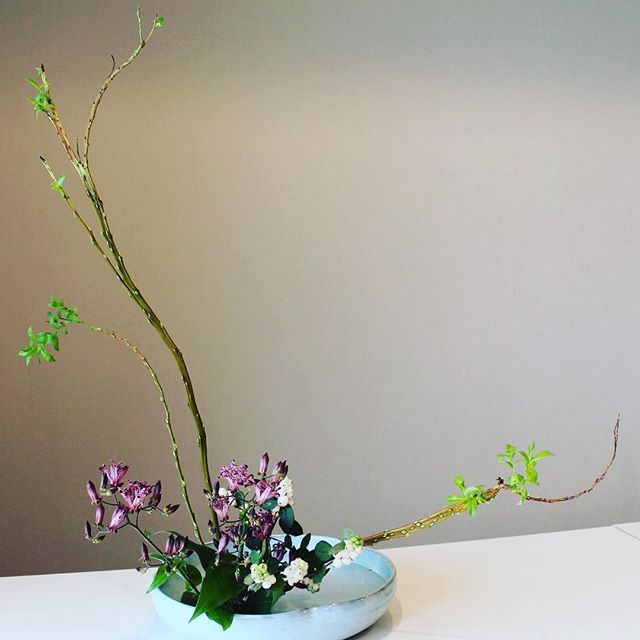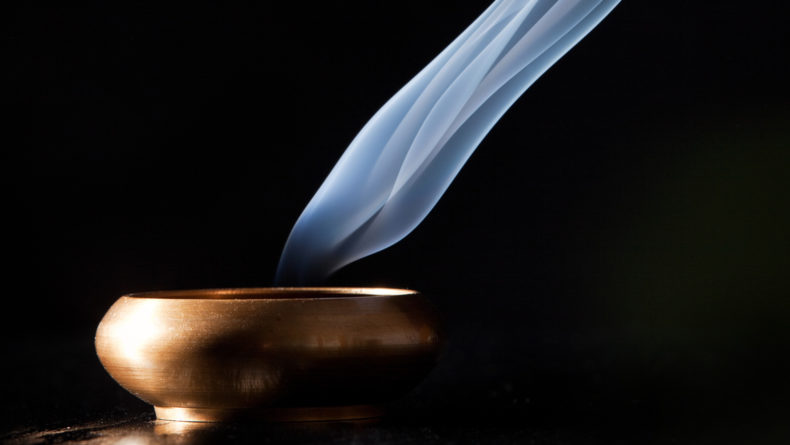Discovering Japanese Floral Beauty with Ikebana Master Flavia Nishimura
Sharing The Artistic And Logical Beauty Of Japanese Flower Arrangements
Flavia Nishimura, a professional ikebana teacher, has been inspiring foreigners in Japan to hone their creativity while learning about a traditional floral Japanese craft.
I found Flavia’s cozy home tucked away on a quiet back street of bustling Shimokitazawa. It was a freezing cold and wet day, yet I instantly felt warmed and welcomed as she greeted me with her beaming smile, a hot cup of chamomile tea, and a fun conversation about her journey. We giggled as she explained to me how ikebana teachers receive a flower name upon certification, with one of the kanji taken from one’s flower teacher. Her flower name is Senran (Fountain of Orchids).

Flavia starts off her ikebana lessons with a demonstration.
Smooth jazz played softly as I watched Flavia demonstrate our ikebana lesson. We were going to use fragrant eucalyptus branches, light green balloon plant milkweed, and light purple Eustoma. I watched her with intrigue as she accurately measured her flowers, placed them delicately at specific degrees, bent branches to achieve the angles she desired, and trimmed leaves for a sharper effect. Every now and then she’d take a step back to observe her composition, then make additional bends and snips until her artistic arrangement was complete.
What inspired you to learn ikebana and to become a teacher?
I have always had an interest in flowers from a young age. I grew up in the countryside of Brazil, and I remember at around age 10 or 11 that my friends would tease me for buying flowers because they thought that flowers were expensive and only lasted a short time. But for me, I always found joy and inspiration in flowers and arrangements. My grandfather is Japanese and when I visited Japan once in 2005, I became intrigued by ikebana. But I couldn’t speak the language well enough at the time to learn about it. So when I moved in 2014, I decided I was going to do it and I dedicated myself to learning and became a teaching master with a degree. In 2017, I started teaching my own classes, Ikebana Experience, through Airbnb Experiences to share the beauty of ikebana with guests from around the world, and my classes have been growing ever since.
 © Photo by ikebanaexperience
© Photo by ikebanaexperience
How long did it take you to become a teaching master?
It took me about three years to become a teaching master. There are five books within the curriculum and each takes a minimum of seven months to finish. Right now, I am a Level 4 teacher and am studying to become a Level 1; it takes about two years to achieve each level.
Did you face any challenges along the way?
I stipulated my own challenges. Every opportunity I had to learn from my master, I would try to do at least two or three ikebanas with different materials within our two-hour sessions. Most students only make one arrangement, because doing more does not make you progress faster in the curriculum. But it is very important to practice and the more I could practice with my master, the more I could have access to different materials, techniques, and my master’s point of view. So the challenges I faced were when I pushed myself, even on my off-days when I was not in the mood.
What is ikebana and what does it mean for Japanese people?
Ikebana, also known as kado, comes from the words ikeru (to arrange, to live), and hana (flower). It is one of the three classical Japanese arts of refinement (the other two are kodo, incense appreciation, and chado, tea ceremony). Ikebana originated from India through Buddhism because flowers were used as an offering to the gods. Then, the Japanese took the flower arrangement concept and made it into what it is today. Today, there are thousands of schools teaching different styles of ikebana across Japan and millions of people practicing the art worldwide.
Ikebana is a reminder to enjoy the little things in life and what we have now.
Ikebana is a philosophy about harmony and appreciating life. Japanese people always have flowers in their homes and the flowers serve as a reminder of the shortness of life and the importance of enjoying the present. You put your passion into making an arrangement but it will soon be gone, so you need to enjoy it now. Ikebana is a reminder to enjoy the little things in life and what we have now.
You mentioned there are many different schools of ikebana. What kind of ikebana do you teach?
I teach the Sogetsu curriculum where we believe that flowers can be arranged by anyone, at any time, and anywhere, with any kind of material. It can be placed anywhere in any room, whether it be your at the front door of your home, in the living room, or in the middle of an office. In Japan, there are over 5,000 Sogetsu schools.
View this post on Instagram
Is there meaning behind each part of an ikebana arrangement?
To create a three-dimensional Sogetsu Ikebana flower arrangement, you need a moribana (a shallow, wide-mouthed vase), a kenzan (a weighted base with dozens of spikes placed within the vase to support the flowers and stems), the flowers, and three stems of different heights called shushi. These three stems are the main branches called Shin, Soe, and Hikae. Shin is the longest stem and represents heaven. Soe is the medium stem and represents human. And the last one, Hikae, represents earth.
How is ikebana different from Western forms of flower arrangement?
What is interesting about the ikebana style of flower arrangement compared to Western arrangements is that it is a blend of both logic and art. On the one hand, there are rules to how you can arrange the branches and flowers according to specific angles and heights, but on the other, you are free to select materials you find beauty in and to create your own design.
 © Photo by ikebanaexperience
© Photo by ikebanaexperience
In ikebana, less is more. Westerners think of flowers in volume whereas in ikebana, you can create an arrangement with only a few elements creating a minimalistic piece where you can enjoy the simplicity of each individual branch and flower.
Also, while Westerners might only consider the arrangement, we have to think about the relationship and balance between the flowers and the container. Once you have created an ikebana arrangement, we say that the flowers have become you, because none of the flowers are what they once identified as before you started.
Why should people consider an ikebana lesson?
You can use ikebana to learn more about yourself. For example, if you are finding yourself fearful of cutting branches or removing leaves, it might be that you are also fearful of letting go of something in your personal life. Once you trim and cut flowers, you cannot go back, so decisions feel more final and scary. You will also learn to feel calm as you need to be comfortable and patient when working with living things.
Once you have created an ikebana arrangement, we say that the flowers have become you, because none of the flowers are what they once identified as before you started.
Is there anything else you would like to share with us?
I welcome anyone, from those who want to simply experience ikebana to those who want to become a professional. I would like to challenge anyone to try no matter your age—don’t be afraid to learn a new art and culture and feel free to come with your partner or your child and have fun learning together. Once you start, you won’t want to stop!
For more information about Flavia’s ikebana classes, check out the official website here or Instagram page.













Leave a Reply